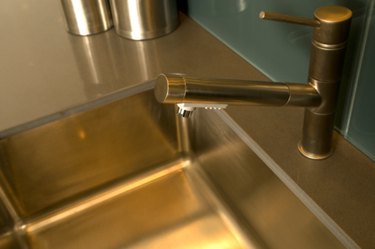Things You'll Need
Bleach-free commercial household cleaner
2 microfiber cleaning cloths
White vinegar
Synthetic scouring pad
Terrycloth towel

Recognized for their strength, longevity and low maintenance, stainless steel sinks are common in household kitchens. While stainless steel sinks naturally resist corrosion, exposure to chlorine bleach, harsh acids and steel wool cleaning pads causes the steel, nickel and chromium in stainless steel to become discolored with rust stains. Rust also develops in scratched or otherwise damaged portions of sinks where the bare metal is exposed to water, oxygen and carbon dioxide. Promptly repair a discolored stainless steel sink to restore the sink's bright, polished appearance.
Step 1
Spray a bleach-free household cleaner over the entire sink. Apply the cleaner as directed by the manufacturer.
Video of the Day
Step 2
Dampen a microfiber cleaning cloth with warm water. Wipe the damp cloth over the entire sink to remove any accumulated food particles, grit and debris. Attempt to remove the rust discoloration.
Step 3
Rinse the sink with fresh warm water to wash away the cleaner and loosened grime.
Step 4
Pour white vinegar liberally onto a synthetic scouring pad. Scrub the remaining discoloration with the pad until the rust disappears. Follow along the stainless steel's grain lines to prevent scratch marks.
Step 5
Saturate a second microfiber cleaning cloth with warm water. Wipe the cloth over the entire sink to rinse away the vinegar, rust residue and any harmful deposits.
Step 6
Rub a terrycloth towel over the entire sink to add shine and prevent mineral stains.
Tip
Substitute 1 tsp. of liquid dish soap combined with 1 qt. of warm water for the bleach-free commercial household cleaner.
Warning
Metal cleaning supplies, such as steel wool, will scratch stainless steel and make it prone to rust.
Video of the Day